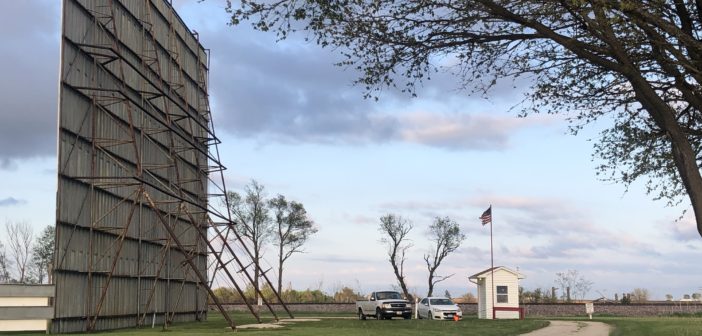An article on History.com, “1933: First drive-in movie theater opens,” states that “Since then, however, the rising price of real estate, especially in suburban areas, combined with the growing numbers of walk-in theaters and the rise of video rentals to curb the growth of the drive-in industry. Today, fewer than 500 drive-in theaters survive in the United States.”
The end of Cascade
In March of 2019, the Cascade Drive-in Theatre located in West Chicago announced it would be closing down permanently. This was upsetting and shocking news for many people since this theater has been around for 58 years. It was one of the last drive-ins in the great Chicagoland area. Now, there are only a few that still remain open in Illinois.
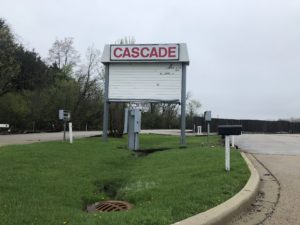
Photo by Madeleine O’Connell
Cascade has closed down because the Kuhn family, who owns the land, wants to try and sell the property. In a post on the Cascade Theater Facebook page, the operator Jeff Kohlberg said, “It’s devastating to us but we always knew the sale would be imminent one day but this scenario of closing with no other use for the property was totally unexpected.”
Many regular movie-goers of this drive-in expressed their sadness in comments on the Facebook page. It was an affordable place for families and pets to come together under the stars and watch a movie.
“It’s a loss for the community but it also reveals the development within the technological realms and how movies, in particular, have shifted from being a communical thing to a small divide,” said Jaidene Samiec, ’21. “That to me is really sad because I think the movies are meant to be experienced with other people you are with.”
One woman, Chris Novielli, was so determined to keep Cascade open that she started a petition. So far, over 30,000 people have signed it.
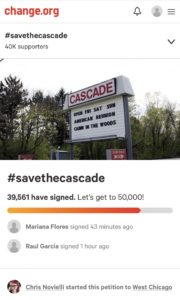
Screenshot by Madeleine O’Connell
“I have been going to Cascade since I can remember,” said Novielli. “I started the petition because it practically is a historical landmark …going to the drive-in was like stepping back in time.”
Along with Novielli, many others want to help save the place that has been creating memories for years.
The feeling of nostalgia provides comfort
Even though some who still go to these outdoor theaters today may not have been around when they first began, the experience can still give off a feeling of nostalgia.
“Nostalgia is this idea of the past. Nostalgia has nothing to do with the actual experience of the past it’s the notion we have of it,” said Chelsea Crawford, visiting assistant professor of English and film and screen studies.
The old technology, the same fuzzy commercials of the dancing hot dogs and the rickety, wooden swing sets that have remained for many years often make people feel comfortable. This is because it reminds them of the good times in their youth.
According to a 2012 article by Psychology Today titled, “What’s so Nice about Nostalgia,” “Retro-themed entertainment feeds into our tendency to reflect back on the positive events that shaped our sense of who we are now. They also reinforce our sense of identity.”
For some, going to a drive-in theater is that break from reality and a chance to remember the good times of the past.
Drive-ins are a way for many different generations to come together to enjoy the same thing. This can sometimes be difficult to achieve with the advancement of technology.
“I’ve watched families grow…they want their families and the next people to enjoy it because they enjoy it,” said Mike Harroun, owner of Harvest Mood Drive-In.
Audio PlayerA new environment for film
This form of entertainment began in 1933 in Camden, New Jersey. People had the option to watch movies outside instead of in a dark theater. “Park-in theatres,” which is what drive-ins used to be called, were invented by Richard Hollingshead. He was a movie-lover but did not enjoy the seating in indoor theaters. He felt that being in your own car in the open-air would be more comfortable. The first experiment with the concept was actually in the driveway of his house using a 1928 Kodak projector. The first drive-in theater Hollingshead opened was called, “Camden Theater.”
He later moved on to opening Park-In Theaters, Inc in 1933. After people got word of this idea, many drive-ins started to appear. The largest was in Copiague, New York which included space for up to 2,500 cars, a playground for kids and a restaurant.
According to the book, “Drive-In Theaters: A History from Their Inception in 1933” by Kerry Segrave, The concessions was opened at the Cadman Theater after the first week. “This was done to reinforce the idea that a drive-in was a place to go and watch a movie, have a meal and a beer, things you couldn’t do in an indoor theater,” said Segrave.
Not much has changed since 1933
Many drive-ins today still offer concessions along with an area for kids to play before the movie starts.
However, even some of the technology has not been recently updated. The speakers used to have to be hooked onto the car. While some drive-ins still use these, at others, viewers have the ability to play the audio through the car radio.
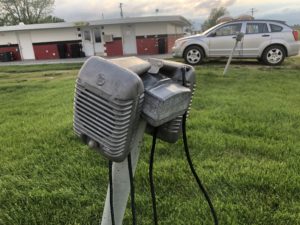
Photo by Madeleine O’Connell
Something that has changed for many drive-in theaters is the costs. The prices have gone up significantly since the start. Hollingshead began by charging 25 cents per car and 25 cents per person for entrance.
“It became possible for a whole group of people to attend the pictures, who previously could not, or preferred not, for one reason or another,” said S. Herbert Taylor in “The Drive-In Theater.”
Now, most drive-ins still pay per person ranging from about free for children and 9 dollars for adults.For many, the price will not deter them from going to the drive-in. It’s the experience they are paying for along with the actual movies.
A silent, dark room versus social interaction and comfort
How someone feels about a film can be altered by the environment in which they watch the movie. Most movies are meant to be seen on a big screen instead of something small like a phone or computer.
One of the biggest differences in going to a drive-in theater versus an indoor movie theater is space/comfort. “You have the ability to be isolated in your car when you’re at the drive-in and then at the movie, you’re stacked row by row and right next to each other,” said Samiec.
Because of the open space, drive-ins also give people the chance to interact with others around them, bringing the community together. “In an indoor theater, you arrive 15 minutes before the show starts and you don’t really have that social interaction,” said Steve Bloomer, owner of Skyview drive-in Theater.
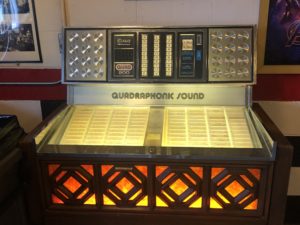
Even though it may not function like it once did, this jukebox still lives in the concessions area of the Route 34 Drive-in. Photo by Madeleine O’Connell
Something else that differentiates the two kinds of theaters is the number of screens. An indoor movie theater may have 18+ screens while a drive-in probably only has one or two screens. Having more screens brings in a bigger revenue since more people can go see several different movies under one roof. At a drive-in, there are usually only two movies playing every week or so.
“If you only have two options to offer…you’re probably going to see a lot of people, who aren’t interested in those two options…go to the multiplex,” said Crawford.
On top of offering a limited amount of movies, drive-ins are also only open during the summer months while indoor theaters are open year-round. This leaves drive-ins with a significantly less amount of income. This makes it difficult to make major improvements which means the vintage theme of the establishments remains.
Even with the competition of large, indoor theaters, the drive-ins that are still open continue to bring in business because of the unique experience they provide for families and friends.

